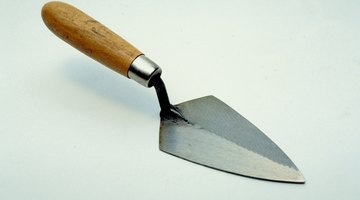How to Build a Small Concrete Block House
Building a small concrete block house is one of the most rewarding projects that you could undertake. The structure will be as strong as any other house and it will last for generations, providing that it is constructed properly.

The best news about building a small concrete block house is that it can be done by the average do-it-yourselfer in three to five days, depending on the size and scope of the project.
Things You Will Need
- Concrete trowel
- Tape measure
- 4-foot level
- Framing square
- Rebar
- Concrete blocks
- Type-S mortar
- Mason's trowel
- Line blocks
- Nylon string
- Block insulation
- 2-by-8 lumber
- Roofing
- Metal framing storm ties
-
Dig and pour the footers at least 12 inches deep and twice the width of the block walls. For example, if you're using 12-inch concrete blocks, then your footers should be 24 inches wide. Add 1/2-inch rebar to the footer--two sticks wide for 16-inch footers and three sticks wide for 24-inch footers. Make sure to rest the rebar on rebar chairs or 3-inch concrete bricks, and don't allow the rebar to touch the dirt within the footer. Place 4 foot long vertical rebar at 4-foot intervals in the center of the footers--these rebars will extend into your block wall cells, which will be filled with mortar.
-
Lay the corners of the block house first. Use type-S mortar to bond the blocks, spreading it out with a mason's trowel. Lay all four corners of your house. Lay the six to eight blocks on each side of the 90-degree corner, checking the block with a square and 4-foot hand level as you work. Stagger the next row of blocks on top of the previous one--the end of the second row should land in the center of the first. Continue to check the corner as you go higher with the blocks. Use the hand level to make sure that the blocks are plum.
-
Place line blocks and nylon string from one corner to the opposite and begin filling in between the corners with concrete blocks. Keep the line blocks set to the top of each corner block as you proceed, and keep the lines tight, so that your block courses will be straight. Build wooden frames for the door and window openings and set them in place when your walls have reached that point.
-
Fill with mortar the cells of the block walls that have rebar and place U-anchor bolts at the tops of the blocks--after the walls have topped out at 8 or 9 feet. Fill all other block cells with cellulose insulation. Make sure that the anchor bolts are straight and square. Once the bolts have set for 24 hours, place 2-by-8 lumber on the top of the walls--this will be the attachment point for your roof. Predrill the holes for the anchor bolts into your 2-by-8 boards, set them in place over the anchor bolts and tighten the bolts down onto the wood.
-
Attach your roof to the building using nails or screws. You may set prefabbed trusses on the roof or stick-build it. Regardless, place the roof framing on 24-inch centers and attach them to the wall plate using roof framing storm ties--metal straps that help hold the roof onto the house walls. Add your roof decking and shingles or tin and trim out the overhangs as desired.
The Drip Cap
- Building a small concrete block house is one of the most rewarding projects that you could undertake.
- Use the hand level to make sure that the blocks are plum.
- Keep the line blocks set to the top of each corner block as you proceed, and keep the lines tight, so that your block courses will be straight.
- Fill with mortar the cells of the block walls that have rebar and place U-anchor bolts at the tops of the blocks--after the walls have topped out at 8 or 9 feet.
- Fill all other block cells with cellulose insulation.
- Regardless, place the roof framing on 24-inch centers and attach them to the wall plate using roof framing storm ties--metal straps that help hold the roof onto the house walls.
References
- "Recommended Practices for Laying Concrete Block;" Portland Cement Association; 1992
- "Guide to Concrete: Masonry & Stucco Projects ;" Phil Schmidt; 2008
- "Building with Masonry;" Dick Kreh; 1998
Resources
Writer Bio
Billy McCarley has been freelancing online since April 2009. He has published poetry for Dead Mule, an online literary publication, and holds a Bachelor of Arts degree from the University Of Alabama where he is also a first-year graduate student in history.
Photo Credits
- Ablestock.com/AbleStock.com/Getty Images
- Ablestock.com/AbleStock.com/Getty Images
More Articles



